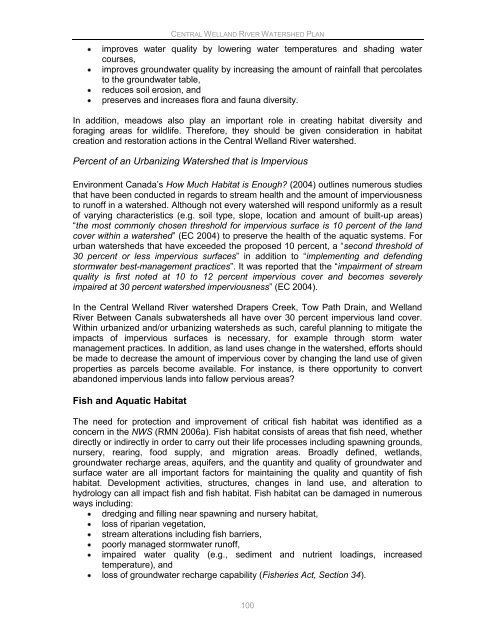Central Welland River Watershed Plan - Niagara Peninsula ...
Central Welland River Watershed Plan - Niagara Peninsula ...
Central Welland River Watershed Plan - Niagara Peninsula ...
- No tags were found...
You also want an ePaper? Increase the reach of your titles
YUMPU automatically turns print PDFs into web optimized ePapers that Google loves.
CENTRAL WELLAND RIVER WATERSHED PLANimproves water quality by lowering water temperatures and shading watercourses,improves groundwater quality by increasing the amount of rainfall that percolatesto the groundwater table,reduces soil erosion, andpreserves and increases flora and fauna diversity.In addition, meadows also play an important role in creating habitat diversity andforaging areas for wildlife. Therefore, they should be given consideration in habitatcreation and restoration actions in the <strong>Central</strong> <strong>Welland</strong> <strong>River</strong> watershed.Percent of an Urbanizing <strong>Watershed</strong> that is ImperviousEnvironment Canada‟s How Much Habitat is Enough? (2004) outlines numerous studiesthat have been conducted in regards to stream health and the amount of imperviousnessto runoff in a watershed. Although not every watershed will respond uniformly as a resultof varying characteristics (e.g. soil type, slope, location and amount of built-up areas)“the most commonly chosen threshold for impervious surface is 10 percent of the landcover within a watershed” (EC 2004) to preserve the health of the aquatic systems. Forurban watersheds that have exceeded the proposed 10 percent, a “second threshold of30 percent or less impervious surfaces” in addition to “implementing and defendingstormwater best-management practices”. It was reported that the “impairment of streamquality is first noted at 10 to 12 percent impervious cover and becomes severelyimpaired at 30 percent watershed imperviousness” (EC 2004).In the <strong>Central</strong> <strong>Welland</strong> <strong>River</strong> watershed Drapers Creek, Tow Path Drain, and <strong>Welland</strong><strong>River</strong> Between Canals subwatersheds all have over 30 percent impervious land cover.Within urbanized and/or urbanizing watersheds as such, careful planning to mitigate theimpacts of impervious surfaces is necessary, for example through storm watermanagement practices. In addition, as land uses change in the watershed, efforts shouldbe made to decrease the amount of impervious cover by changing the land use of givenproperties as parcels become available. For instance, is there opportunity to convertabandoned impervious lands into fallow pervious areas?Fish and Aquatic HabitatThe need for protection and improvement of critical fish habitat was identified as aconcern in the NWS (RMN 2006a). Fish habitat consists of areas that fish need, whetherdirectly or indirectly in order to carry out their life processes including spawning grounds,nursery, rearing, food supply, and migration areas. Broadly defined, wetlands,groundwater recharge areas, aquifers, and the quantity and quality of groundwater andsurface water are all important factors for maintaining the quality and quantity of fishhabitat. Development activities, structures, changes in land use, and alteration tohydrology can all impact fish and fish habitat. Fish habitat can be damaged in numerousways including:dredging and filling near spawning and nursery habitat,loss of riparian vegetation,stream alterations including fish barriers,poorly managed stormwater runoff,impaired water quality (e.g., sediment and nutrient loadings, increasedtemperature), andloss of groundwater recharge capability (Fisheries Act, Section 34).100
















